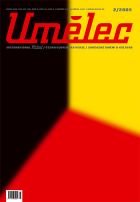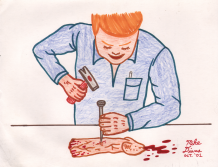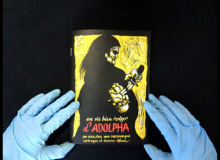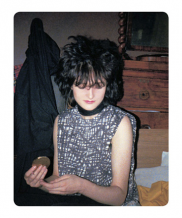| Umělec 2005/2 >> IBCA – Prague Biennale 2: Two Visits at Once | Просмотр всех номеров | ||||||||||||
|
|||||||||||||
IBCA – Prague Biennale 2: Two Visits at OnceUmělec 2005/201.02.2005 Jiří Ptáček | commentary | en cs de |
|||||||||||||
|
At the beginning of the year, Oliver Kielmayer, a Swiss publisher, arranged a meeting in the Umělec editorial office. He wanted some consultation. He had accepted an offer from the Prague National Gallery to curate the International Biennale of Contemporary Art (IBCA). He said he had no idea he would be entering a chaotic quarrel between the IBCA and Prague Biennale 2.
The IBCA is organized by the National Gallery with Milan Knížák, the NG general director, as its leader. The Prague Biennale is being prepared by the publisher of Flash Art magazine, Giancarlo Politi and Helena Kontová, his wife. Three years ago, the three were working together. Today, they can not even bear to hear each other’s names. Several times the informed media and cultural public reacted by creating groups of sympathizers and opponents on either side. As a publisher of the samizdat We are the Artists, Kielmayer has decided to dedicate the following issue exclusively to Prague and both Biennales. Anybody can contribute, and the resulting printed magazine will be Kielmayer’s curatorial contribution to the IBCA. The second visit to Umělec took place about a month ago. A member of the Czech group Guma Guar, Richard Bakeš, wanted to inform us about the project for Prague Biennale 2. It is a samizdat publication entitled Bie2nale, which concurs in all principle aspects with that of Kielmayer. What is going on that necessitates people to take sides in a quarrel between two major institutions? We can not analyze the events associated with the Prague Biennales without noticing the way they snowball irrelevant information and prejudices. Anyone trying to analyze all this will come into contact with a closed society of public representatives, their concept of dialog, and the dubious role of the local mass media. The concepts, artists presented, curators, or contributions to the local culture have not been discussed in either of the biennales. At issue, rather, are the scrambles among a few people and their individual charismatic personas, and particularly the NG general director, Milan Knížák. Milan Knížák is favorite topic in the Czech media. With pleasure, he enters discussions about art and cultural policy, and he comments on the most common issues of everyday social life. He is a guarantee of cross-social discussion: he is not an intellectual; on the contrary, he can charm with his simplicity, or with the way he hotly attacks his opponents. He has held his position in the media since the 1990s, and it seems that he is very unlikely to lose it. Another position Knížák holds is the role of scapegoat. His name is a magnet for problems, from time to time he is even blamed for something that originated in completely different contexts. His obscure propositions about Romany people and uninformed characterizations of Josef Koudelka’s photographs wrecked havoc; but in the case of the Tapestry – Sweet Goods exhibition in the Small Atrium of the Veletrzni Palace a media outcry was undeservedly aroused. By canceling the show after having issued the catalog and sending out invitations, he acted unusually. However, in doing so he actually prevented further deterioration of the reputation of the Veletržní Palace’s exhibition program, already considered to be weak and haphazard. The media panned Knížák, while the director of the Modern and Contemporary Art Collection, and the exhibition curator, Tomáš Vlček, remained unmentioned. Vlček is the one responsible for the Veletrzni Palace curators, overall concepts, use of financial resources from the state institution budget, as well as communication difficulties within the National Gallery. The reaction to the cancellation of the Tapestry – Sweet Goods might be read as a shift of attention from real problems to the media figure of Milan Knížák. The media’s interest in the responsibility for the problems of the National Gallery and its hierarchy is scarce. The most comprehensive article on the figure of Knížák, which appeared recently, was published in the prestigious Respekt weekly, in 10/2005. Its author, Petr Třešňák, often alludes to the situation in the National Gallery, the position of Knížák’s staff, but only in passing. The above-mentioned Tomáš Vlček is only present in the remarks, in the same artice, of Umělec magazine publisher Ivan Mečl. However, they lack matter-of-fact basis, and Třešňák uses them to support his discussion of the authoritative behavior of the general director. Since Milan Knížák has been constantly opposing whatever criticism there is of the NG, the staff can rely on the fact that any criticism will be understood as criticism of Knížák himself. Apart from occasional retorts by the general director, none of the staff can answer for their own failures. What is more, the media makes no effort to do it; they deal with people known only to a limited number of experts. It is understandable that journalists follow the patterns of other spheres. What is alarming is that members of the cultural scene have become so narrowed. Those Who Speak Milan Knížák is an active artist. He values his works, therefore he incorporated them into the exposition at the Veletrzni Palace. Because he used to be the rector of the Academy of Fine Arts, and still teaches there, he keeps close contacts with members of the contemporary art scene. And artists and contemporary art scholars are his fiercest critics in the post of the general director of the NG. The dialog is focused merely on the Modern and Contemporary Art Collection, and the fact that Knížák directs a huge institution with a few collections is secondary. It is worth noting the action in which art students expressed their disagreement with Knížák’s directorial activities by defecating in a room of the Veletrzni Palace. Knížák’s strongest mass media opponent, Jiří David, an artist too, comes to the similar narrowing. David uses the media to attack the most explicit of Knížák’s mistakes. Even though David’s artistic and intellectual attitude varies from those of Knížák, in the media they seem similar: they are hot-blooded, personal, intolerant, therefore suitable for publication. David’s last escapade was an open letter addressed to Petr Lysáček and Jiří Surůvka after they had accepted curatorial responsibilities for the IBCA. His reproachful tone was directed towards other artists as well, particularly Michal Pěchouček who had sold his paintings to the National Gallery. For both the defecating students and for the hot-tempered David, Milan Knížák embodies somebody who violates the image of cultural life. Whether or not their opinions have any legitimacy, lacking is any holistic analysis of the general director’s activities. He mainly manages the Modern and Contemporary Art Collection of the National Gallery. To be sure, cultured protests that assess the collections and exhibition activities, do appear; but not in the form of political campaigns. One of the best is Myself I Praise and Exhibit. With it Martina Pachmanová, an art critic, in the supplement of the Mladá Fronta Dnes daily, entered the Knížák discourse in 2004. After the Respekt article, David Kulhánek, a curator of the Display gallery, tried to demonstrate that culture functions even without Knížák. It was a unique, original, and dispassionately expressed opinion. Still knowledgeable analysis and deliberate thinking plays a marginal role in the mass media. A radical gesture provokes a greater response. For these reasons, the mainstream of the discussion circulates endlessly. Biennale of Disrespect Also in case of the IBCA and Prague Biennale 2 it is Milan Knížák who is pilloried. Giancarlo Politi besides enforced such rhetoricism, when explaining the awkward quarrels in the last Biennale, which were too strong even to be compared with Knížák. Most of the text for the press conference of Prague Biennale 2 was dedicated to the relationships between the two sides, but here as well he failed to provide any basis to support his contention. The generally emotive text unnecessarily contained improper references to Milan Knižák calling him “Master K,” “Mister K,” “and Milan K.” The text of Politi first and foremost must be understood as propaganda of Prague Biennale 2. The Czechs however welcomed it as a long-awaited explosive. It seemed that foreigners had begun to deal with our own problems. Unfortunately the explosive turned out to be a sparkler. Politi lacked the courage to bore readers and impose unquestionable evidence of Knížák’s wrongdoings on them. Then a few similarly unclear affirmations of the general director ended the duel in a tie. “Politi and Kont used to be my friends, but since the time I enabled them to misuse the National Gallery for their own personal achievements, I have become their enemy,” announced Knížák with the same weight as Politi’s “Master K.” Backstage Sulking When Alena Boika, Umělec magazine’s Belarusian Editor, came to Prague in April, she turned to me, and in all honesty said she could not understand the situation with the Biennales. “Could you tell me which Biennale is the main one?” she asked. The fuss associated with the Prague Biennale organizers publicized Prague at least on a European scale. Although Politi’s event inherited the name and Flash Art magazine’s support, we can not say that the “main” attribute is associated with the laws of succession. The “main” one will become the Biennale that radically influences the Czech situation. The lists of curators and artists are attractive at both Biennales; the monstrosity of both is comparable, and the subheadings (“Another View” in the case of IBCA, and “Between New Painting and Political Action” for Prague Biennale 2) broadly encompass future output. The sole curatorial sections of both Biennales do not compete. It can be expected that the public will visit both, and the pouting of its leaders will remain unnoticed. Seeking the “main” Biennale will be possible only on the level of art criticism. The newspaper of Oliver Kielmayer and the group Guma Guar have already begun, and are counting on the “quality” and “mosaic” effect. The “main” will be substituted by “better” and “more successful.” New media constructions will matter. At the present state of public dialog, the question is whether the Biennale analysis will be affected by difficulties in finding positions that would not stick to usual mass medial behavior patterns. If so, in two years we will again be witnessing similarly unproductive wars without weapons.
01.02.2005
Рекомендуемые статьи
|
|||||||||||||
|
04.02.2020 10:17
Letošní 50. ročník Art Basel přilákal celkem 93 000 návštěvníků a sběratelů z 80 zemí světa. 290 prémiových galerií představilo umělecká díla od počátku 20. století až po současnost. Hlavní sektor přehlídky, tradičně v prvním patře výstavního prostoru, představil 232 předních galerií z celého světa nabízející umění nejvyšší kvality. Veletrh ukázal vzestupný trend prodeje prostřednictvím galerií jak soukromým sbírkám, tak i institucím. Kromě hlavního veletrhu stály za návštěvu i ty přidružené: Volta, Liste a Photo Basel, k tomu doprovodné programy a výstavy v místních institucích, které kvalitou daleko přesahují hranice města tj. Kunsthalle Basel, Kunstmuseum, Tinguely muzeum nebo Fondation Beyeler.
|






























 New book by I.M.Jirous in English at our online bookshop.
New book by I.M.Jirous in English at our online bookshop.
Комментарии
Статья не была прокомментированаДобавить новый комментарий